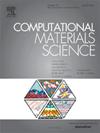锂致铝合金晶界脆化的原子尺度机制:第一性原理研究
IF 3.3
3区 材料科学
Q2 MATERIALS SCIENCE, MULTIDISCIPLINARY
引用次数: 0
摘要
本研究采用第一性原理计算研究了锂(Li)在铝(Al)晶界(GBs)的偏析及其对界面力学性能的影响。我们的研究结果表明,孤立的Li原子与大多数GBs相互作用弱,其结合行为与局部电荷密度分布密切相关。随着锂离子浓度的增加,明显的聚类行为出现:在Σ5(310)、Σ17(410)和Σ13(320) GB处沿倾斜轴形成一维线性链,而在Σ5(210) GB处形成稳定的平面锂单层。Li偏析主要通过诱导邻近Al原子之间的局域电子耗竭来减弱界面内聚。不同GB类型的锂偏析程度及其减弱效果不同。具体来说,如Σ5(210)和Σ43(335)等gb合金极易因Li偏析而发生脆化,而其他gb合金如Σ3(112)和Σ17(223)对界面结合强度的影响很小或没有影响。这些原子的见解为晶界工程策略提供了信息,该策略优先保留耐锂GB结构,同时抑制锂敏感配置。这种方法为增强铝锂合金的抗断裂性而不影响其轻量化优势提供了路线图。本文章由计算机程序翻译,如有差异,请以英文原文为准。

Atomic-Scale mechanisms of Lithium-Induced grain boundary embrittlement in aluminum alloys: A First-Principles study
This study employs first-principles calculations to investigate the segregation of lithium (Li) at aluminum (Al) grain boundaries (GBs) and its influence on interfacial mechanical properties. Our results reveal that isolated Li atoms interact weakly with most GBs, with binding behavior strongly correlated to the local charge density distribution. As Li concentration increases, distinct clustering behaviors emerge: one-dimensional linear chains form along tilt axes at Σ5(310), Σ17(410), and Σ13(320) GBs, while a stable planar Li monolayer forms exclusively at the Σ5(210) GB. Li segregation weakens interfacial cohesion primarily by inducing localized electron depletion between neighboring Al atoms. The extent of Li segregation and its weakening effect varies across different GB types. Specifically, GBs, such as Σ5(210) and Σ43(335), are highly susceptible to embrittlement due to Li segregation, whereas other GBs, such as Σ3(112) and Σ17(223), show minimal or no effect on interfacial bonding strength. These atomistic insights inform a grain boundary engineering strategy that prioritizes the retention of Li-tolerant GB structures, while suppressing Li-sensitive configurations. This approach offers a roadmap for enhancing fracture resistance in Al-Li alloys without compromising their lightweight advantages.
求助全文
通过发布文献求助,成功后即可免费获取论文全文。
去求助
来源期刊

Computational Materials Science
工程技术-材料科学:综合
CiteScore
6.50
自引率
6.10%
发文量
665
审稿时长
26 days
期刊介绍:
The goal of Computational Materials Science is to report on results that provide new or unique insights into, or significantly expand our understanding of, the properties of materials or phenomena associated with their design, synthesis, processing, characterization, and utilization. To be relevant to the journal, the results should be applied or applicable to specific material systems that are discussed within the submission.
 求助内容:
求助内容: 应助结果提醒方式:
应助结果提醒方式:


